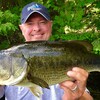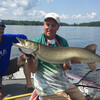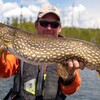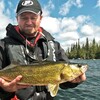
Top 10 Fly Patterns for Ontario Brook Trout

Northern Ontario is blessed with fabulous Brook Trout populations in both rivers and lakes. From May until September, you have a fantastic opportunity to catch these wonderful trout on a wide range of topwater flies. Here are some of our favourite fly choices which are proven patterns on all types of water systems in Northern Ontario.
1. Adams Dry Fly

Adams Dry Fly – designed by Leonard Halladay from Michigan in 1922, this is considered by many as the best dry fly to cast out for trout when you’re unsure of what insect is hatching. It is considered a general imitation of an adult mayfly, flying caddis or midge. For anglers, it is a “must-have” in their fly boxes in sizes 10 to 16.
2. Humpy Dry Fly

Humpy Dry Fly – Tied in yellow or red (or even “royal” fashion), the Humpy is a high-floating dry fly that imitates a host of bugs, from larger mayflies to caddis, but doesn't exactly resemble anything in particular. It just looks buggy and it really works well. In Northern Ontario, we’ve found the best colours are yellow, green and red in sizes 8 to 16.
3. Stimulator Dry Fly

Stimulator Dry Fly - The Stimulator is a dry fly popularized by the angler, fly tier and author Randall Kaufmann to imitate large adult stoneflies. The Stimulator is commonly thought of as an attractor, or searching pattern because it can resemble many things while imitating nothing in particular. And the Brook Trout go for it, big time! In large sizes (8-12) and dressed in a salmon-orange or yellow body, it can be used to resemble the large black stonefly, also known as the giant salmon fly. Skate this fly over moving water and then “hang on” as trout will explode on this deadly pattern.
4. Goddard Caddis Dry Fly

Goddard Caddis Dry Fly - British fly tyers John Goddard and Clive Henry created the Goddard Caddis back in the early 1960s for lakes and Stillwater fishing, and it eventually found its way to North America in the 1970s. The Goddard Caddis features a spun deer hair body and several turns of brown hackle from the thorax to the hook eye, making it a perfect caddis imitation to throw in faster currents common in Northern Ontario's small streams and rivers. Like the Stimulator, this pattern skated on the surface incites explosives strikes by Brook Trout.
5. Elk Hair Caddis Dry Fly

Elk Hair Caddis Dry Fly - This is probably the most well-known caddis pattern in existence, and rightly so. The Elk Hair Caddis as it is also known is one of the best adult caddis patterns that you could use. Throughout North America, this pattern is relied upon, and every season it never fails to produce Brook Trout. You can fish this pattern dry so that it just floats high on the hackle points, you can fish it half-drowned so that it gurgles like a popper when retrieved and you can even fish it wet just under the surface. Tie with a brown, green or yellow body, it works in sizes 10 thru to 16. A brilliant and proven all-around pattern for Brook Trout in Northern Ontario.
6. The Chernobyl Ant

The Chernobyl Ant – This foam-based fly pattern imitates a high-protein meal Brook Trout can't resist, and variations of the pattern have been successfully used in Northern Ontario for years. It was invented for use on the Green River in Utah by guide Allen Woolley who replaced the hackle used on foam grasshopper patterns with rubber legs, and the modern Chernobyl Ant was born. Brook Trout in Northern Ontario generally like this fly large, in sizes 8 thru to 12. You can dead-drift this fly or skate it over moving water. Epic surface takes are almost guaranteed with this fly.
7. GFA or General Foam Hopper

GFA or General Foam Hopper – The warm summer sun has nurtured a new hatch of grasshoppers, beetles and ants to maturity. Add a touch of a breeze, and you have big, fat bugs on the water, and Brook Trout love them! There are numerous grasshopper or big imitation patterns available but this is one of our favourites because it is easy to tie and exceptionally deadly when fishing for trout. Cast the GFA pattern near fallen logs, grassy edges and foam lines, they get the attention of big trout that are just waiting for that perfect meal to come floating by. The GFA Hopper is a great, buggy, easy-to-tie pattern that not only works on its own but also works as an excellent indicator with a nymph or a smaller dry fly trailing behind it
8. Morrish Mouse

Morrish Mouse – Big Northern Ontario Brook Trout love to eat hapless mice that fall into rivers and lakes. Ken Morrish’s ‘Morrish Mouse’ is arguably one of the most well-known and effective mouse patterns ever created. However, originally tied on a traditional down-riding hook, some believe the original Morrish Mouse has a tendency for shorter strikes and potentially a higher rate of tongue hooked fish compared to mouse patterns tied with an up-riding stinger hook. So many tie this pattern as a tube fly and use a small stinger hook to help catch big Brook Trout. Cast this fly near river structures, over pools and even at the edge of darkness when mice come out to play…then hang on!
9. Gurgler

Gurgler – This fly pattern, invented by Jack Gartside, was originally designed for Smallmouth Bass but over the years, many have realized this pattern is deadly for Brook Trout. The Gurgler is a great pattern for aggressive fish in both freshwater and saltwater. This fly can imitate a frog, mouse, and more for Brook Trout lying in wait. This fly can either be stripped aggressively to fool ambush feeders or defensive fish like Pike or stripped slowly to imitate a baitfish. However, you fish it, this is one of the most popular fly patterns for aggressive fish. It can be tied in a variety of styles and colours...but our favourite is a purple body with a white foam back. Sizes 4 to 6 work best skated across the surface or slowly and rhythmically retrieved.
10. Deerhair Bass Bug

Deer Hair Bass Bug – Some are surprised when they learn many of the surface patterns designed for bass are equally deadly for Brook Trout. Bass bugs, which usually feature a flat vertical head, are made to imitate lures such as Hula Poppers or Rebel Poppers. The secret to the deer hair bass popper is the “pop” it makes on the surface of the water when you retrieve it. To big Northern Ontario Brook Trout, this imitation of a mouse, frog or some other high-protein food source has a simple principle….it rings the dinner bell! Cast deer hair bass bugs in sizes 1/0 to 6 near structure, over deep pools and on the edges of fast-moving water. Brown, black and even yellow seems to work well.
These ten fly patterns are an excellent choice to bring to Northern Ontario when hunting the “Crown Jewel of the North”. Whether fishing small streams, rivers or lakes, these ten patterns will ensure you have success when surface fishing for wild Brook Trout!
Recommended Articles

10 Facts About Lake of the Woods

Bear Creek Bruisers
Ontario Brook Trout

Blue Heron Resort

Baptiste Bass

Predicting Lake Thickness

Casting for Coasters

Top 5 Flies for Smallmouth Bass

The Best of Both Worlds

French River Fever

Wild Brook Trout

Mississagi Multi-Species Magic

Ontario’s Fishing Gems: Algoma and Sunset Country

Grand Tappattoo Resort: Fishing Adventures Near the GTA

Double Trouble for Fall Crappies

Walleye on Lake Temiskaming

Easy Pickin's for Northern Ontario Panfish

Salmon Fishing

Multi-Species Fly-Fishing


















